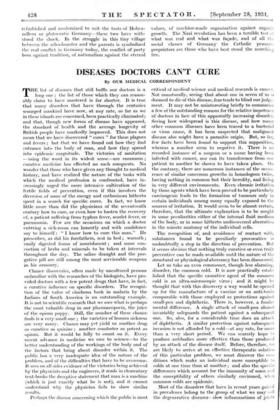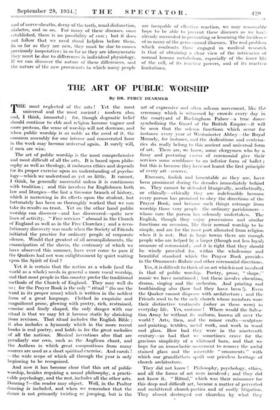DISEASES DOCTORS CAN'T CURE
By OUR MEDICAL CORRESPONDENT
THE list of diseases that still baffle our doctors is a long one ; the list of those which they can reason- ably claim to have mastered is far shorter. It is true that many disorders that have through the centuries scourged mankind have now, at any rate, so far as we in these islands are concerned, been practically eliminated; and that, though new forms of disease have appeared, the standard of health and the average longevity of British people have markedly improved. This does not mean that we have discovered " cures " for these plagues and fevers ; but that we have found out how they find entrance into the body of man, and how they spread into epidemic magnitude. The victories of sanitation —using the word in its widest sense—are enormous ; curative medicine has effected no such conquests. No wonder that those who have given any thought to medical history, and have realized the nature of the tasks with which the medical profession is confronted, have in- creasingly urged- the more intensive cultivation of the fertile fields of prevention, even if this involves the diversion of some of the energy and enthusiasm hitherto spent in a search for specific cures. In fact, we know little more than did the physicians of the seventeenth century how to cure, or even how to hasten the recovery of, a patient suffering from typhus fever, scarlet fever, or pneumonia. Few are the occasions on which a doctor entering a sick-room can honestly and with confidence say to himself : " I know how to cure this man." He prescribes, as did his forefathers, rest in bed ; warmth ; easily digested forms of nourishment ; and some con- coction of herbs and minerals to be taken at intervals throughout the day. The saline draught and the pur- gative pill are still among the most serviceable weapons in his armoury.
Chance discoveries, often made by uncultured persons unfamiliar with the researches of the biologists, have pro- vided doctors with a few potent drugs that have, in fact, a curative influence on specific disorders. The recogni- tion of the value of cinchona bark in malaria by the Indians of South America is an outstanding example. It is not to scientific research that we owe what is perhaps the most valuable drug in our pharmacopoeia, the juice of the opium poppy. Still, the number of these chance fmds is a very small one ; the varieties of human sickness are very many. Chance may yet yield us another drug as curative as quinine ; another comforter as potent as opium. But it would be folly to count on it. Every recent advance in medicine we owe to science—to the better understanding of the workings of the body and of the factors that bring about disorder within it. The public has a very inadequate idea. of the nature of the problem, and of the difficulties that have to be overcome. It sees on all sides evidence of the victories being achieved by the physicists and the engineers, it reads in elementary text-books the deceptive statement that man is a machine (which is just exactly what he is not), and it cannot understand why the physician fails to show similar results.
Perhaps the disease concerning which the public is most critical of medical science and medical research is cancer. Not unnaturally, seeing that about one in seven of us is doomed to die of this disease, fear tends to blind our judge- ment. It may not be uninteresting briefly to summarize a few of the outstanding reasons for the relative impotence of doctors in face of this apparently increasing disorder. Seeing how widespread is this disease, and how many other common illnesses have been traced to a bacterial or virus cause, it has been suspected that malignant disease also might have a parasitic origin. But, so far, few facts have been found to support this supposition, whereas a number seem to negative it. There is no recorded instance of a surgeon or a nurse having been infected with cancer, nor can its transference from one patient to another be shown to have taken place. On the contrary, there are numerous instances of the occur- rence of similar cancerous growths in homologous twins, having nothing in common but their heredity, and living in very different environments. Even chronic irritation by those agents which have been proved to be particularly carcinogenic leads to the formation of tumours only in certain individuals among many equally exposed to the sources of irritation. It would seem to be almost certain, therefore, that the ultimate explanation is to be sought in some peculiarities either of the internal fluid medimu of the body, or in some hitherto undiscovered aberration in the minute anatomy of the individual cells.
The recognition of, and avoidance of contact with, substances found to be peculiarly provocative is undoubtedly a step in the direction of prevention. But it seems obvious that nothing truly curative or even truly preventive can be made -available until the nature of the structural or physiological aberrancy has been. discovered.
Let us take an even commoner, though less alarming, disorder, the common cold. It is now practically estab- lished that the specific causative agent of the common cold is an ultra-microscopic virus ; and it might be thought that with this discovery a way would be opened up for the manufacture of a vaccine or an anti-toxin comparable with those employed as protections against small-pox and diphtheria. There is, however, a funda- mental difference. A single attack of small-pox almost invariably safeguards the patient against a subsequent one. So, also, for a considerable time does an attack of diphtheria. A similar protection against subsequent invasion is not afforded by a cold—at any rate, for more than a very short period. We can scarcely hope to produce antibodies more effective than those produced by an attack of the disease itself. Before, therefore, we are likely to arrive at an effective therapeutic solution of this particular problem, we must discover the con- ditions which make an individual more susceptible to colds at one time than at another ; and also the specific differences which account for the immunity of some and the susceptibility of others similarly environed, when common colds are epidemic.
Most of the disorders that have in recent years gained in prevalence belong to the group of what we may call the degenerative diseases—slow inflammations of joints and of nerve-sheaths, decay of the teeth, renal disfunct ion, diabetes, and so on. For many of these diseases, once established, there is no passibility of cure ; but it does not follow that we need stand helpless before them. In so far as they are new, they must be due to causes previously inoperative; in so far as they are idiosyncratic they must be due to differences in individual physiology.. If we can discover the nature of these differences, and the nature of the new provocants to which many people are incapable of effective reaction, we may reasonably hope to be able to prevent these diseases as we hay.. already succeeded in preventing or lessening the incidence of so many of the germ-caused illnesses. The real problem which confronts those engaged in medical research is. that of obtaining a clear view of the intricacies of normal human metabolism, especially of the inner life of the cell, of its reactive powers, and of its reactive limitations.



















































 Previous page
Previous page